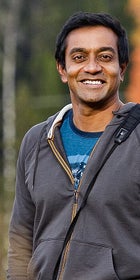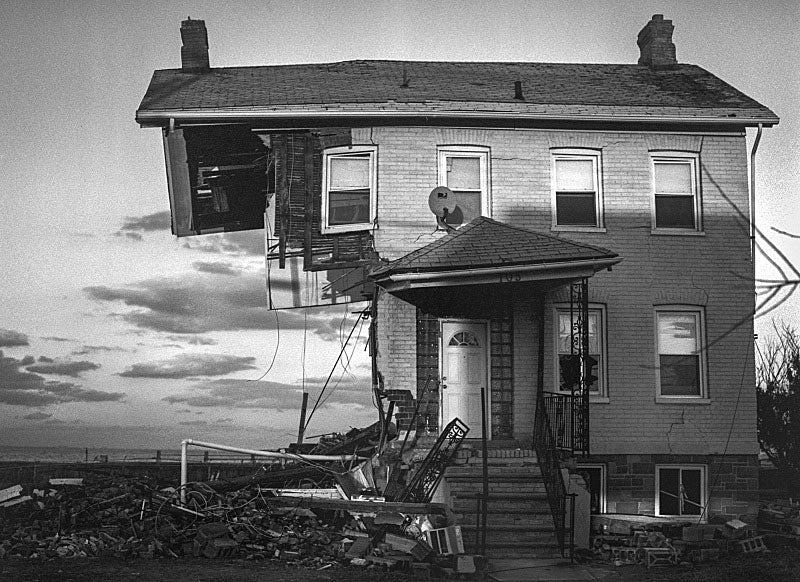What will it take to wake up the public to the urgency of climate change? How about a hunky pitch-man like Ian Somerhalder, star of Lost and The Vampire Diaries, speaking out about coal-energy alternatives? Or Harrison Ford, zipping around in a jet, collecting greenhouse gas readings? Or a hard-hatted Schwarzenegger on the front lines of a wildfire?
 M. Sanjayan, one of the hosts in a new Showtime series on climate change.
M. Sanjayan, one of the hosts in a new Showtime series on climate change.This is the kind of true Hollywood treatment global warming gets in the new Showtime series, Years of Living Dangerously.
“This is 60 Minutes meets Oceans 11,” says Heidi Cullen, lead climate scientist at and a science advisor on the series. “The actors bring not just a way to learn more about the issues, but they have tremendous social reach. Ian Somerhalder can bring [climate change] to a whole new audience.”
The program, which begins streaming live April 7, and airing on Showtime beginning April 13, is well-timed. The latest report from the United Nation’s Intergovernmental Panel of Climate Change (IPCC) is dire. It effectively says: Look, climate change isn’t some far-off boogeyman. It’s real. It’s intensifying poverty and wars. It is changing migration patterns, and screwing up the seasons and ocean health.
Ford, Schwarzenneger, and Somerhalder, are joined by other notables, including Jessica Alba, Don Cheadle, Mark Bittman, Thomas Friedman, and scientist/correspondent/activist M. Sanjayan, who serve as correspondents. The program is executive produced by Schwarzenneger, James Cameron, Jerry Weintrab, and former 60 Minutes Producers Joel Back and David Gelber, and weaves dozens of stories about the ways climate change is already affecting people around the world.
“It was really import to make sure we had reach. We wanted to link storytelling to this issue that has not, somehow, penetrated large sectors of the American public,” says , who created the show along with Bach. “We wanted to focus on stories we thought were most compelling, are character-based, and have uncertain outcomes—stories that are interesting even to people who don’t care that much about climate change.”
The show’s opening credit sequence are stylistically similar to that of the espionage Showtime series Homeland, which only serves to make the intensity of the nonfiction stories covered in the show—from Superstorm Sandy to increasingly intense and deadly forest fires—more biting.
Joe Romm, another science advisor on the series and the editor of , says Showtime should be lauded for taking on this project. “There is not a single show on television devoted to Climate Change. [Years] is what Climate Change looks like. This is the greatest story of our time.”
Best known for reporting on food, Mark Bittman covers different beats in two Years segments—one about how New Jersey is, and is not, rebuilding for resilience after Sandy, and one that uncovers the truth about how much methane contributes to climate change (spoiler: a lot).
“We talked to some very knowledgeable people, and I really learned a lot about methane, which is much more potent a greenhouse gas than carbon dioxide,” he explains. “We made statements and predictions, in terms of methane leaking from infrastructure and fracking and so on, that a year ago were controversial. Now they’re spot on.”
In addition to the series, says Gelber, national education and engagement campaigns, including a MOOC, partnerships with groups such as the World Wildlife Fund, and large viewing parties, are in the works. “The goal is to galvanize a national conversation on climate change.”
Recently, I caught up with M. Sanjayan, executive vice president and senior scientist at Conservation International and Years correspondent, about his two tough assignments for the show.
���ϳԹ���: What’s the backstory? How did you become involved with Years of Living Dangerously?
M. Sanjayan: When I was first approached I said no, actually. I had done a series for Discovery Channel on energy, and even though it was a critically acclaimed series, it just didn’t grab people’s attention very much…and I just knew how very difficult it would be to talk about climate change on film.
I really became convinced after having multiple conversations with [executive producers and show creators] Joel Bach and David Gelber. James Cameron was on board, they didn’t have stars line up yet at the time, though they gave me a sense of who would be involved. But there were three things that they said that really convinced me. One: We would be talking about the present, not about things that might happen in the future. Two: More philosophically, they told me, “Look, the key thing with 60 Minutes is that we always have good characters. And we will make this about characters you can get engaged with.
Third: They said, “Hey you’re going to up to 20,000 feet in the Andes [to collect ice samples] and to a coral atoll in the middle of Pacific. That was part of the pitch.
What about this series do you think will resonate with people?
There is no doubt that the celebrity status of the correspondents will make people sit up. But what will matter is that these are real people and real lives conveyed in a compelling and interesting way. It goes back to story, which is what it takes to make a good film. You can’t do science. You can do story. The reason Carl Sagan’s vision worked is not because he was talking about really high science, it’s because it became a story—a big yarn.
I saw a clip from the series showing you guys on horseback, high in the Andes, collecting ice core samples with climatologist Paul Mayewski. It really seemed very hard core.
I’ve done eight or nine documentaries now. I’ve done shark week. And I’ve never come close to thinking I was going to die. It was honestly—in fact, we all agree—it was more than we bargained for. It was really, really tough because we went up so fast. We were at base camp at about 11-thousand feet, and we went up to 20 in one day…. Of the 12 people who set off, four did not make it to the top. Our number one camera guy became violently ill. The second camera guy, a Chilean guy who was flown in from Santiago, had his head was kicked in by a horse. One of the local guides was thrown from his mule at altitude, on a slope, and broke his collarbone, and a post-doc couldn’t summit with us.
My oxygen saturation at the summit was under 78 percent. It was hard keeping coherent thoughts in my head and speaking to camera.
As climate science becomes a more popular field of study it seems like there is a growing intersection between the mountaineering community and dudes in lab coats. Do you agree?
Yes and no. Paul Mayewski doesn’t give you the impression of being a badass—even though he is, and he’s going out to the ends of the earth. But he is also very cautious and a very thoughtful scientist. Going to the Pacific with Kim Cobb [a climate scientist from Georgia Tech], it’s not like we were doing anything extremely dangerous, diving near Christmas Island Atoll. But she was operating a really big drill, under water.
Mayewski is a late-carrier guy who looks like he could be Shackleton. His discoveries are really dramatic. He studies wind and how it can change, as a way to show how quickly climate can change. I asked him off camera: “Are you talking disaster-movie scary?” He said, yeah, it could be disaster-movie scary. So I asked how quickly. He said in 10 years we could see dramatic change, and in fact that’s what’s happening in the Arctic.
What if the series, by using drama and megastars and quote-unquote elite media to tell the story, has the unintended consequence of further polarizing and politicizing the issues, rather than galvanizing people around efforts to do something about climate change?
The way I see it, there are still going to be a few people in this country who stand there and say climate isn’t changing. Honestly, that’s a pretty small slice of the pie. Most corporate leaders don’t believe that anymore and to be honest I don’t think many politicians do, either.
Where we are going to have a fight is over what we do about it. You’re absolutely right, we could have done this show in different ways with a different group of people. But I don’t know if that would have changed the trajectory. I think it takes a lot of people coming at this in a lot of ways to move forward.
Here is my bet: a year from now, we’ll be much more focused on what to do rather than whether [climate change is] real. I can almost feel a groundswell of support and I think this show will tip it over the top. The people who are on principal against it are going to stay against it. But I just look at the scale of some of these disasters happening now and I don’t think people are going to want to duck this one.
Point taken. Plus, it’s not like a storm surge can discriminate between a climate change denier and a believer.
Not at all, but it will discriminate the poor from the rich. It will hurt those who can afford it the least.


